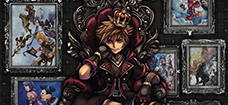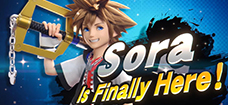Gameplay
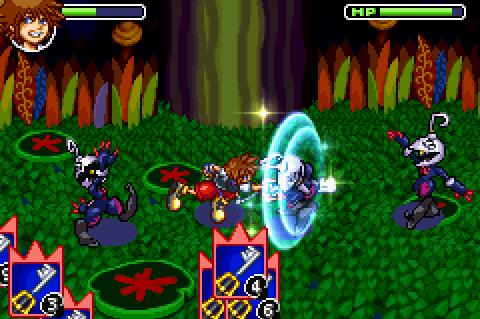 Originally released on the GBA, Chain of Memories marks a major departure from the series by utilizing an innovative combat and exploration system revolving around cards, crafted from Sora's memories of his previous adventure. A notable feature are the field map and battle screen. The field map is an isometric area where the player can traverse between rooms. Enemies inhabit the field map and track the player to engage in combat, which can be initiated through contact between the player and an enemy. Once combat has been engaged, the game switches to the battle screen.
Originally released on the GBA, Chain of Memories marks a major departure from the series by utilizing an innovative combat and exploration system revolving around cards, crafted from Sora's memories of his previous adventure. A notable feature are the field map and battle screen. The field map is an isometric area where the player can traverse between rooms. Enemies inhabit the field map and track the player to engage in combat, which can be initiated through contact between the player and an enemy. Once combat has been engaged, the game switches to the battle screen.
The game makes use of all the buttons of the GBA: The D-Pad is used for movement, the A button is the multi-purpose Action Button (used to swing the Keyblade or make a selection). The B button is used for both jumping and canceling menus. In battle, pressing L shifts your card deck to the right, or clockwise, while pressing R shifts your card deck to the left, or counter-clockwise. The START button is used for to access the menu outside of battles and pauses the game during battles. Holding the button down skips cutscenes. Finally, the Select button displays the World Map when Sora is on the field, while in battle, it switches between the normal deck and Enemy Cards.
Combat is executed in real time, wherein the player can jump and maneuver around the battle screen as they would on the field map, but all physical attacks, magic, items, and summonings are activated by playing cards. Cards are ranked from zero to nine, and are used for making attack combos. Combining cards in sets of three will create combo attacks that are more difficult to break. Certain card combinations will create a "Sleight", a special combination that will create a powerful physical attack, magical spell, or summon attack. Using a card combination will cause the first card in the combo to become unusable until the end of combat.
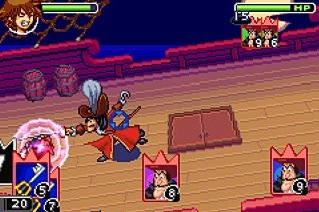 Just as Sora uses cards, so too do his enemies. Enemies will attack Sora using their cards,which are displayed in the center of the screen. If Sora and an enemy both play a card simultaneously, the card with the higher number wins. Card Break occurs when the loser's card is broken and the loser reels back for a moment. The winner's card and attack go through.The sole exception to the normal "higher numbers beat lower numbers" rule is the very special 0 card. You can use a 0 card to break any attack that is coming at you; however, as long as the 0 card is in play,the next attack that comes along will break it.
Just as Sora uses cards, so too do his enemies. Enemies will attack Sora using their cards,which are displayed in the center of the screen. If Sora and an enemy both play a card simultaneously, the card with the higher number wins. Card Break occurs when the loser's card is broken and the loser reels back for a moment. The winner's card and attack go through.The sole exception to the normal "higher numbers beat lower numbers" rule is the very special 0 card. You can use a 0 card to break any attack that is coming at you; however, as long as the 0 card is in play,the next attack that comes along will break it.
Sora also has access to special cards that do not have numbers on them. These include the Enemy Cards, which grant Sora a special advantage in battle. The Select button switches from the normal battle deck to the Enemy Card Deck and the bottom left corner next to the card list displays this advantage along with an indicator of how long it lasts. The second type of special card is the Gimmick Card, which will be rewarded to the player once certain conditions are fulfilled during boss battles. It can be used to break a boss's attacks and gives you a major advantage in battle.
Once all of the player's cards are used up, the card deck can be reloaded at any time by going to the black card square and holding down the A button until your gauge is full. The number on the card gauge determines how many times you must refill it until the cards return to you. The gauge starts off at 1, but each reload increases the meter by 1 to a maximum of 3 consecutive reloads. Sora has to stand still as he reloads (unless he uses a certain card to lift this restriction), making him very vulnerable to enemy attack while he calls back his deck. If Sora completely loses all his cards, the player's only option is to flee from battles by running to the edge of the battlefield and keep pressing the D-pad in that direction in order to fill up an Escape Gauge. Escape can be interrupted by enemy attacks or if you let go of the D-pad; once interrupted, the gauge resets back to 0.
When Sora defeats an enemy, that enemy will drop experience balls which you must collect in order to level up. Do note that experience balls disappear if you haven't collected them within a certain amount of time. Once Sora gains a level, the player is able to increase one of the following fighting capacities: HP Boost, CP Boost and a new Sleight (although this is not always available). Sora can go up to level 99, but he can only maximize two of the three bonus categories. This form of leveling up allows players to customize Sora according to whichever suits their playing styles.
 A fresh addition to the game is room synthesis where players need to utilize Map Cards obtained from winning battles. Rooms need to be synthesized in order to advance through a floor, allowing the player a certain degree of control over the world map, although each floor layout is fixed. Once you leave a floor, the map resets itself and you must resynthesize all rooms anew if you choose to return.This is useful when you need to level up as rooms have a limited number of enemies. A room can only be synthesized if its Card Value is 0 or higher than the requirement listed along with the door in question. Storyline and Key to Rewards rooms have their own requirements, The properties of each room are determined by the Map Cards that the player chooses. Each card has a specific effect, may it be on the enemies, on the power of Sora's deck, or on the room itself. The Yellow Cards are the Storyline or Key to Rewards room.
A fresh addition to the game is room synthesis where players need to utilize Map Cards obtained from winning battles. Rooms need to be synthesized in order to advance through a floor, allowing the player a certain degree of control over the world map, although each floor layout is fixed. Once you leave a floor, the map resets itself and you must resynthesize all rooms anew if you choose to return.This is useful when you need to level up as rooms have a limited number of enemies. A room can only be synthesized if its Card Value is 0 or higher than the requirement listed along with the door in question. Storyline and Key to Rewards rooms have their own requirements, The properties of each room are determined by the Map Cards that the player chooses. Each card has a specific effect, may it be on the enemies, on the power of Sora's deck, or on the room itself. The Yellow Cards are the Storyline or Key to Rewards room.
Reverse/Rebirthcontinues the card-based gameplay of Castle Oblivion, but with a few major changes. Riku is equipped with a closed deck which cannot be customized and is entirely dependent on the floor he is on. His moves are limited to physical attacks and certain Enemy Cards. To compensate however, Riku does not need as much time to reload his deck. In keeping with his character arc, Riku does not have access to any of the friend cards that Sora had with the exception of King Mickey. Riku's dark powers are his staple weapon throughout the game, and they are triggered by taking damage or breaking his opponent's cards. When his Dark Points exceed 30 or above, Riku will automatically go into Dark Mode. In Dark Mode, Riku has access to extremely powerful dark-based Sleights. How long Dark Mode lasts depends on how much DP he has, and taking damage reduces the amount of DP Riku has left in a given battle. Leveling up requires Riku to upgrade his HP, AP (Attack Power), and DP (Dark Points) stats.
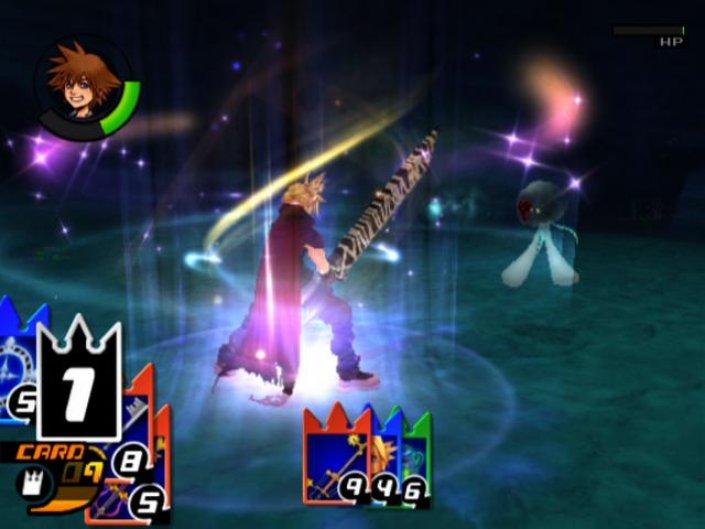 The transfer of Chain of Memories to the PS2 saw very few changes in the controls, with the X button and the O button replacing the A and B buttons respectively. Exclusive to the PS2 however are Reaction Commands, a feature previously implemented in Kingdom Hearts II. Activated using the Triangle button, the Reaction Command is used to strike up a conversation with NPCs or for interacting with the environment, basically taking over most of the functions of the GBA's A button. During Riku's story, the Reaction Command is essential for initiating a Card Duel, which occurs whenever Riku and his enemy deal cards with the same number. Riku needs to continuously break his enemy's cards in order to achieve a special attack. Finally. the camera also becomes more user-friendly through the use of the right analog stick. Otherwise, the lack of major changes has allowed Re:Chain of Memories to retain the charm and uniqueness of the original GBA game.
The transfer of Chain of Memories to the PS2 saw very few changes in the controls, with the X button and the O button replacing the A and B buttons respectively. Exclusive to the PS2 however are Reaction Commands, a feature previously implemented in Kingdom Hearts II. Activated using the Triangle button, the Reaction Command is used to strike up a conversation with NPCs or for interacting with the environment, basically taking over most of the functions of the GBA's A button. During Riku's story, the Reaction Command is essential for initiating a Card Duel, which occurs whenever Riku and his enemy deal cards with the same number. Riku needs to continuously break his enemy's cards in order to achieve a special attack. Finally. the camera also becomes more user-friendly through the use of the right analog stick. Otherwise, the lack of major changes has allowed Re:Chain of Memories to retain the charm and uniqueness of the original GBA game.


